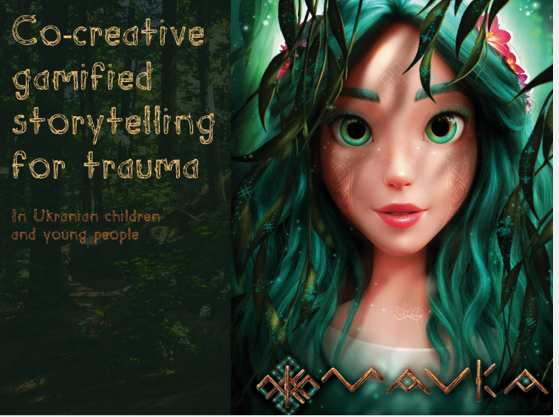MAVKA: Co-creative gamified storytelling for trauma in Ukrainian young people (European Crucible Pitch Winner 2022)

| Dr Mel McKendrick | Heriot-Watt (SoSS, Psychology) |
| Dr Igor Tereshcenko | NGO Enligthen, Ukraine |
| Dr Carolyn Jess-Cooke | University of Glasgow (School of Critical Studies) |
| Dr Mathieu Chollet | University of Glasgow (School of Computing) |
Overview
Early trauma has been associated with increased threat sensitivity and reduced reward sensitivity (Marusak et al., 2015). Post-traumatic stress disorder (PTSD), attention deficit hyperactivity disorder (ADHD), panic disorder, anxiety disorders, sleep disorders are reportedly common to young children exposed to war and conflict whilst in older children, trauma may manifest behavioural problems and conduct/oppositional defiant disorders. Social functioning may also be adversely affected by conflict stigma in post war societies. (Frounfelker et al., 2019). More ever the displacement of young people across host countries could exacerbate the stigma by conferring migrant status on them.
Storytelling allows us to organize and make sense of information in an organised way whilst combining elements of play. Pennebaker’s work on storytelling for trauma (1999), which proved that the development of stories are critical for supporting mental and physical health, provides a conceptual framework for the ways in which narrative is used in this project. Other studies, such as that directed by Fernandez and Paez after the 2004 terrorist attack in Madrid, provide similarly strong indicators of storytelling as a modality for improving wellbeing and assisting participants who have experienced trauma in their emotional processing and organising of memories.
The aim of the project is ultimately to develop a serious game platform to provide children and young people with an opportunity to engage in using mixed media (creating a visual world/ storytelling) to process some emotion and trauma. The goal of the application would be to offer children and young people directly experiencing or displaced by the war in Ukraine, a means for distraction and a vehicle for expressing emotion without having to talk directly about their own experiences. The immediate goal of the first stage of this project was to gain insight into the needs and coping mechanisms of young people in Ukraine in addition to gauging their insights and suggestions for the most appropriate story telling environment that may work across stages of adolescence before extending the concept to younger ages.
Method
Children and adolescents were asked to create their own story including location, hero, villain/obstacle, hero and villain meet and outcome. Example stories were The Forest Song and The Gillie Dhu
In total, 27 participants took part in the research and they were divided into two groups. Group one resided closer to the conflict in Ukraine while group two resided further away from the conflict. Group one consisted of 12 participants who ranged in age from 7-16 years while group two consisted of 15 participants. The aim of the research was to determine if there were any differences between the groups in how they experienced the war and made sense of it. To achieve the aim of the research, participants were asked to write a story of their choice. The content of these stories was analysed using Braun and Clarke’s version of thematic analysis (reflexive thematic analysis), which was conducted following the six phases outlined by Braun and Clarke (2006).
Results
Group 1
Closer to conflict group, three themes emerged: ‘defending Ukraine from Russia’; ‘the personal impact of the war’ and ‘living in peace before dreaming of peace’.
“This could have lasted forever (peace), but one morning, a black fog descended on the land.” “In these lands, brave and courageous warriors stood guard over the dream country’s lands.”
“One day, Anya heard from her mother about the war in Ukraine, about how people were being killed and their homes destroyed. The girl became very sad and scared.” “The girl woke up from her mother’s dreadful words: The war has started. It was hard for a girl.”
“Far away and just as long ago, there was a wonderful kingdom, peaceful and tranquil.” “She dreamt that peace would come to our country and the sun would shine in the peaceful sky.”
Group 2
From the further from conflict group, two themes emerged: ‘Ukrainian soldiers rise to challenge Russia, the destroyer of peace’ and ‘belief that Ukraine will win the war’.
“One day he had to leave his homeland, because the evil invaders arrived. They destroyed and ruined everything in their wake.”
“The sons rose to defend their mother. Each of them had a fragment of strength, spirit, and talent of the renowned hero Ivan Syla, who was the strongest on the planet.”
Latest news
We presented the findings from the first phase of the MAVKA project at The Royal Society of Edinburgh February 22-23 and the team is now looking forward to progressing the next phase of the project. You can listen to a podcast about the project by clicking the link below.
https://www.supa.ac.uk/opportunities/careers/career-paths/storytelling-and-games-address-trauma
References
Frounfelker, R.L., Islam, N., Falcone, J., Farrar, J. Ra, C., C.m., Antonaccio, Enelamah, N. & Betancourt, T.S. (2019). Living through war: Mental health of children and youth in conflict-affectedareas. International Review of the Red Cross, 101 (911), 481–506, Children and war, doi:10.1017/S181638312000017X
Marusak, H., Martin, K., Etkin, A. et al. Childhood Trauma Exposure Disrupts the Automatic Regulation of Emotional Processing. Neuropsychopharmacol 40, 1250–1258 (2015). https://doi.org/10.1038/npp.2014.311
•
Mastoras, R. E., Iakovakis, D., Hadjidimitriou, S., Charisis, V., Kassie, S., Alsaadi, T., … & Hadjileontiadis, L. J. (2019). Touchscreen typing pattern analysis for remote detection of the depressive tendency. Scientific reports, 9(1), 1-12.
•Pennebaker, J. W. (2000). Telling Stories: The Health Benefits of Narrative. Literature and Medicine 19(1), 3-18. doi:10.1353/lm.2000.0011.
